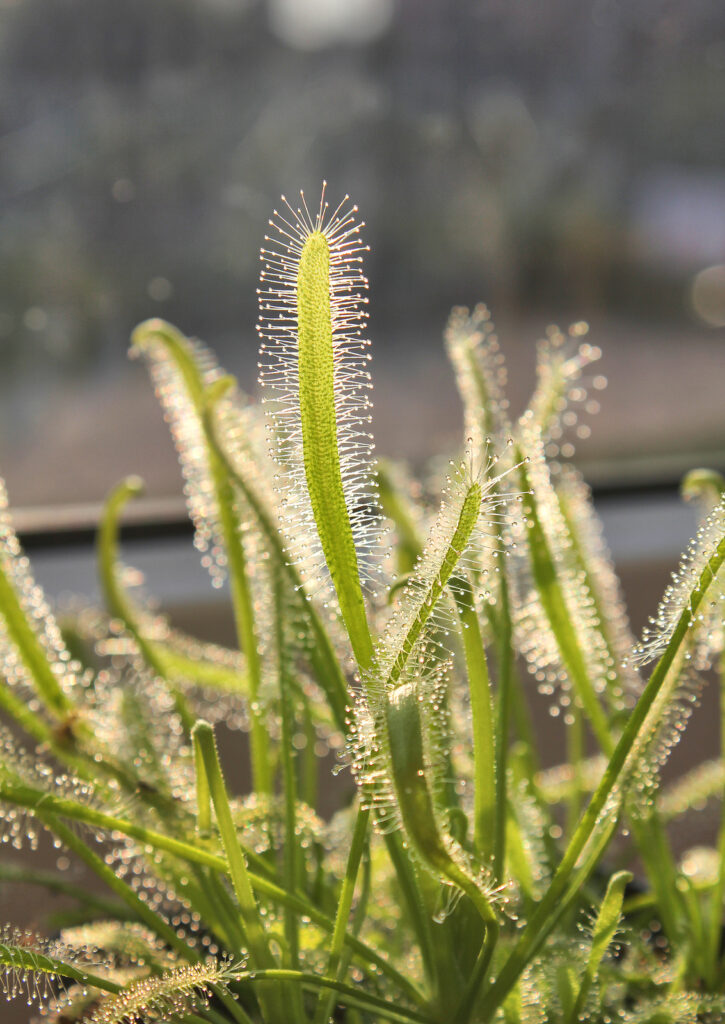Drosera–commonly known as the sundews–is a large genus of carnivorous plants, with at least 194 species. Droseraceae lure, capture, and digest insects using stalked mucilaginous glands covering their leaf surfaces.
Drosera’s stalked glands secrete sweet mucilage to attract and ensnare insects. When insects land on the sticky glands they are unable to escape and eventually die of exhaustion; the plant’s enzymes then turn the insects into a kind of nutrient soup that the plant can digest through its leaf surfaces.
Drosera species are found in both tropical and temperate parts of the world. All species are able to move their tentacles in response to contact with edible prey. The tentacles are extremely sensitive and will bend toward the center of the leaf to bring the insect into contact with as many stalked glands as possible.
Drosera is a genus of about 100 species. They are found in poor, acidic, boggy soil throughout the world, but mainly in Australia.
Drosera is often grown as a houseplant in a terrarium where the soil mix can be kept constantly moist.
Get to know Drosera
- Plant type: Evergreen carnivorous bog plant
- Growing zones and range: Zones 6-10 depending on the variety
- Hardiness: Half hardy or tender depending on the variety
- Optimal growing temperature: day, 60°F (16°C); night; 42° to 51°F (6° to 11°C).
- Height and width: 4 to 12 inches (10-30cm) tall, 6 inches (15cm) wide
- Foliage: Alternate or whorled, long stalked linear to almost circular leaves fringed with gland-tipped, red or green hairs, which trap and digest insects
- Flowers: Small five-petalled flwoers, usually white, also pink and purple
- Bloom time: Summer
- Uses: Houseplant, bottle garden or terrarium is an ideal location, tropical plant
- Common name: Sundew
- Botanical name: Drosera
- Family name: Droseraceae
- Origin: Australia

Where to plant Drosera
- Light indoors: Drosera needs bright light.
- Light outdoors: Full sun or bright light with shade from hot midday sun
- Soil indoors: Peaty potting soil mixed with equal parts sand or sphagnum moss.
- Soil outdoors: Humus-rich peaty soil that is well drained.
When to plant Drosera
- Set Drosera outdoors in summer.
Planting and spacing Drosera
- Space Drosera 6 inches (15cm) apart.
How to water and feed Drosera
- Water: Keep the soil mix moist to wet at all times to simulate Drosera’s natural environment.
- Feeding: Fertilize Drosera once a week in spring and summer.
Drosera care
- Drosera is senstive to aerosol spray; do not use insecticides near Drosera.
Growing Drosera as a houseplant
- Drosera needs bright light, an average temperature, and high humidity.
- The soil should be kept moist to wet at all times to stimulate Drosera’s natural environment; a terrarium is an ideal location.
- The best planting medium is sphagnum moss.
- If Drosera does not catch insects, it should be given fertilizer once a week in spring and summer.
Drosera pests and diseases
- Drosera is rarely damaged by pest, but it is susceptible to powdery mildew.
- Do not use insect sprays near Drosera.
Drosera propagation
- Drosera can be propagated from seed, from leaf cuttings or by division.
Drosera varieties to grow
- Drosera binata. Long, thin stems that split into a T shape at the ends; stems may be maroon or green.
- D. capensis, cape sundew. Rosettes of linear-oblong to spoon-shaped leaves to 2½ inches long covered with glandular red or green hairs; grows 8 to 12 inches tall.
- D. filiformis. Green stems that are curled at the ends.
- D. intrermedia, love nest sundew. Grow to 6 inches tall; obovate leaves in a basal rosette.
- D. linearis. Form loose basal rosette; white flowers.
- D. rotundifolia, round-leaved sundew. Ground-hugging rosettes of bronze leaves ½ to 2 inches long. Leaves have rounded ends, are ½ inch wide and resemble tentacles hairs are red.















